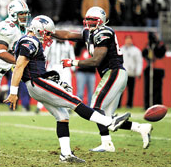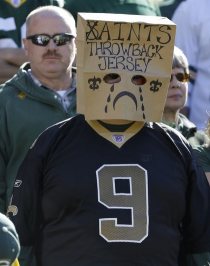Sure, the Cardinals and Steelers missed the playoffs last year, but they did go 6-2 in the second half. (Not to sound like a Holiday Inn Express commercial or anything.) That was the best record by any team that didn’t qualify for the postseason. How much does this mean, though? Are these clubs on the verge of greater things, or does a strong finish one year have little bearing on the next?
Let’s look at the previous four years and the teams that earned this distinction:
[table width=”350 px”]
Year Team (W-L),2nd Half,Next Season
2012 Cowboys (8-8),5-3,8-8
2012 Panthers (7-9),5-3,12-4
2011 Cardinals (8-8),6-2,5-11
2010 Chargers (9-7),6-2,8-8
2009 Titans (8-8),6-2,6-10
[/table]
A bit surprising, you have to admit. Three went backward the next year, one stayed stuck in its 8-8 rut and the other — the Panthers — won the division title (and got a first-round bye in the playoffs).
But that’s a rather small sample size. So I researched the matter further — back to 1990, when the playoffs were expanded to 12 entrants. A total of 39 clubs in those 24 seasons fell into the Best Second-Half Record By A Non-Playoff Team category (accounting for ties). Here’s how they did the following year:
[table width=”250 px”],,
Made playoffs,15
Missed playoffs,24
Wild card, 7
Division champion, 8
Reached conference title game, 5
Reached Super Bowl, 3
Won Super Bowl, 1
[/table]
As you can see, almost two-third of the clubs (61.5 percent) failed to qualify for the playoffs the next season. The last four years, in other words, are no aberration. For teams such as these, there simply isn’t much of a carry-over effect. Indeed, 24 of them — the same 61.5 percent — failed to improve their record the following season, much less make the playoffs. (Fifteen were better, 19 were worse and five posted the same mark.)
The clubs that reached the Super Bowl, by the way, were the 1998 Falcons (7-9 the year before, 6-2 in the second half), 2003 Patriots (9-7/5-3) and ’08 Cardinals (8-8/5-3). And the only one that walked off with the Lombardi Trophy, of course, was the ’03 Pats, who had won it just two seasons earlier (and would win it again in ’04).
The moral: Don’t get your hopes too high if your team finishes its season on an upswing. It could lead to greater success, but the odds are against it. Why? Oh, you could probably come up with a bunch of reasons — injuries, free-agent defections, a tougher schedule, bad luck, and on and on. Then, too, winning games when you’re out of the running – as many of these clubs were – is a lot like gaining yards when you’re hopelessly behind. They might make things look a little better, but looks can be deceiving.
Sources: pro-football-reference.com, The Official NFL Record and Fact Book



